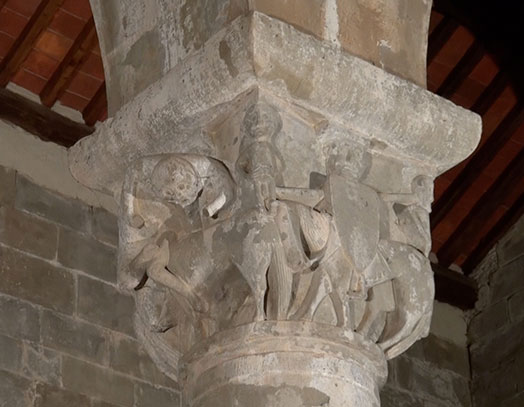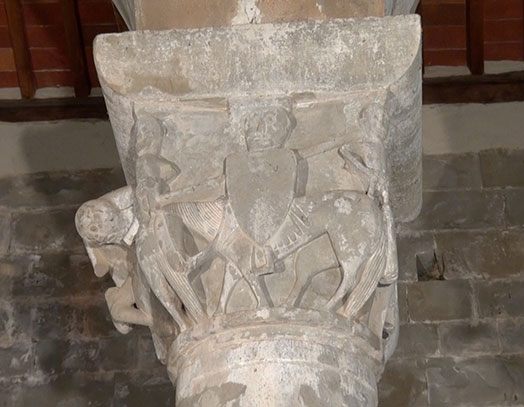THE CAPITAL of the KNIGHTS
right nave, first column
This capital is a “moving picture”: three of the four horses are being ridden by knights armed with lances and large triangular shields of the old French type; the fourth horse has, seated backwards on its rump, and with both legs on the same side, what at first appears to be an old man in a curved pose, with his right leg lifted and his elbows bent. Four small nude male figures appear on the four corners, standing with their arms in different positions: on the hips, on the stomach, on bent legs and on the head of one horse (the other arm of this figure is missing, but a fragment indicates that it must have been turned towards the knight’s spear).
The interpretation of these figures has given rise to various hypotheses, above all for the presence of the old man whom Gandolfo (2003) identified as a version of the famous Boy with Thorn, or Spinario, the Hellenistic bronze known from numerous copies which, in the Middle ages, were in the square of the Basilica of San Giovanni in Laterano (donated to Rome in 1471 by Pope Sixtus IV and today in the Capitoline Museums), and which was also interpreted as a representation of lust. This reading was reinforced for that scholar by the presence of the nudes on the corners and of the knights, seen as representing a violent and un-Christian way of life. Mons. Moretti (2004) overturned the symbolism of the knights, however, preferring to focus on the principles of knighthood and identifying the three knights as paladins of the Christian faith, in opposition to the male nudes, a symbol of paganism and lust. The fourth mounted figure would have been Theodoric, king of the Ostrogoths, who, according to a legend, at his death was abducted by a black horse, actually a demon, and thrown into the crater of Stromboli as punishment for his having persecuted Christians. For don Moretti the capital was to be read as the battle between virtue and vice, as suggested by the Latin poem Psycomachia by Prudentius (4th century).
The more qualified interpretations are therefore of lust or the struggle of virtue against vice. It is true that the Boy with Thorn is often represented in the Romanesque period on façades or inside churches, as, for example, in the cathedral of Trani, or in the mosaic floor of that of Otranto. The figure in Gropina has lost some of its limbs (lower arms and right foot) and on the back of the horse one notes a circular base; what appears to be the beard of the man, unlike the manes and tails of the horses, drawn by vertical lines, is smooth, perhaps because of the difficulty of using the scalpel without damaging the arms of the figure. If it really represents the Spinario, then, as Gandolfo suggests (2003), the horse was included in order not preserve intact the symmetry of the whole group.
But there is an important aspect, never before brought to light for Gropina. In a study appearing online in the site of the Diocese of Milan, IncrociNews.it, Luca Frigerio calls attention to representations of the Spinario in medieval churches found along the pilgrimage routes, recognizing in the thorn a double meaning: the obvious one, as a physical hindrance in the march of the devoted on their way on foot to Rome or to Santiago di Compostela, and the symbolic one, the thorn as allegorical of sin and of the consequent divine punishment and also of the obstacles that impede responding in full to the Word of God and to following the path towards salvation. The Spinari appearingin the churches along the pilgrimage routes therefore have a magical and symbolic valence: according to Frigerio, they "refer to the very condition of the pilgrimun, who in order to complete his journey, spiritual even before material, must free himself from those ‘thorns’ which slow down his march and which symbolize the sins, or superfluous possessions, or prejudices..." or even heresy. The pieve of Gropina, as we have seen, is found along a pilgrimage route, the via Sancti Petri, the portion of the Cassia Vetus which led those devotées of the prince of the apostles, those desirous of visiting his tomb, to Rome.
The three knights are also susceptible of various readings: as we have seen they can represent either the purity of life and defense of the Christian faith, or dissolute conduct (the numerous tales of love in the chansons de geste) and the passion for war. In addition, knights of different colours, and numbering three as here, can incarnate other types of valor: the Green Knights is the neophyte or the initiated; the Red is the conqueror, baptized in blood; the White Knight stands for the powers of evil and also atonement and sacrifice. In a general sense a man on horseback is the spirit guiding a body: its search is that of the voyage of the soul through the world with its temptations and obstacles to be overcome, in the ocurse of which the person undergoes trials and advances towards perfection. An esoteric and philosophical meaning, often present in medieval churches, combines well with those explicitly religious one, enriching its value.
The author of this capital is the same stone-cutter who sculpted the capital with the rampant lions, similar in their stylistic motifs, and also the next one, executed at the end of the building phase of the pieve of Gropina.


